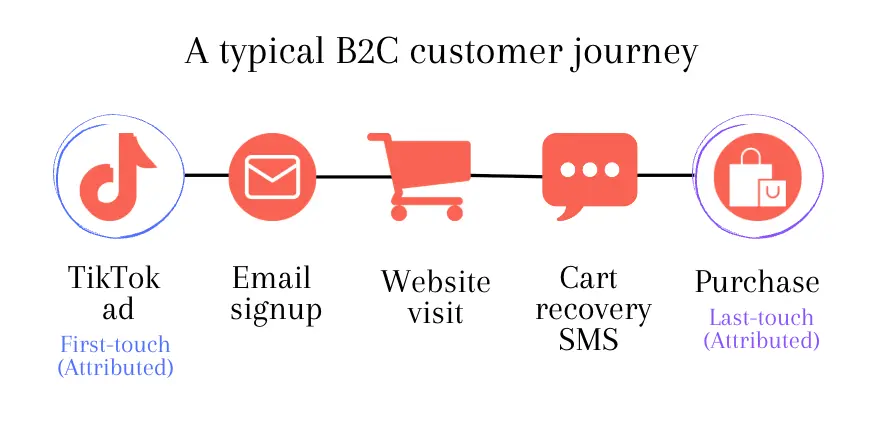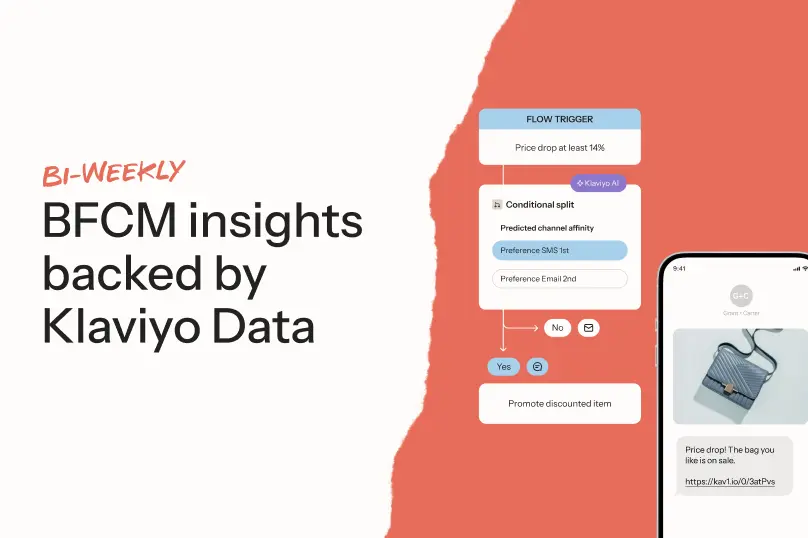Single-touch vs. multi-touch attribution: what B2C marketers need to know
A customer doesn’t just wake up and decide to buy from you. They might see a paid ad, click a link in an email, browse your site a few times, and get an abandoned cart text before they finally convert.
But if your reporting only credits the last thing someone clicked, you’re not seeing the full picture.
That’s the role of marketing and advertising attribution: tracking which touchpoints actually contribute to a sale. Do it right, and it helps you spend smarter and focus on what’s working. But use the wrong model, and you risk over-investing in the wrong channels or cutting tactics that are quietly doing the heavy lifting.
In this article, we break down two core marketing attribution models: single-touch vs. multi-touch attribution. We explain how the latter gives B2C marketers a far more accurate, useful, and actionable view of performance—especially when you do it in a B2C CRM that unifies all your data.
What is single-touch attribution?
Single-touch attribution is a model that gives all the credit for a conversion to just one touchpoint in the customer journey, usually either the first or the last.
There are two main types of single-touch attribution:
- First-touch attribution gives credit to the first interaction a customer has with your brand. It’s useful for measuring brand awareness efforts, like if someone discovers your brand through a TikTok ad.
- Last-touch attribution gives all the credit to the final action a customer takes before purchase. It’s by far the most common model (and often the default in many tools), but it can oversimplify complex decision-making processes that lead to sales.

Pros of single-touch attribution
- It’s easy to set up and understand, especially for smaller teams or brands just getting started with attribution.
- It can be fairly effective for simple, short buying cycles where decisions happen quickly.
Cons of single-touch attribution
- It completely ignores all the other interactions a customer has before they buy.
- It can lead to misleading conclusions about what’s really driving sales.
- It tends to overvalue either top-of-funnel (first-touch) or bottom-of-funnel (last-touch) tactics, which means you might end up underinvesting in the stuff in between that’s often nudging people toward conversion.
Let’s say a shopper sees one of your TikTok videos and clicks through to your site. A few days later, they sign up for your newsletter. Then, a week after that, they get an abandoned cart text message and finally decide to buy.
In a last-touch model, only that final text message gets the credit. The TikTok ad and the email sign-up—the two moments that first sparked interest and kept the customer engaged—get zero recognition.
That’s the problem with single-touch attribution: it tells just one part of the story.
What is multi-touch attribution?
Rather than assigning 100% of the credit for a sale to a single touchpoint, multi-touch attribution spreads the love across every step in the journey. That might mean giving partial credit to the Instagram ad that sparked interest, the email campaign that nudged the customer along, and the well-timed text message that sealed the deal.
There are a few ways to split that credit:
- Linear gives equal credit to every touchpoint.
- Time decay gives more credit to interactions that happened closer to the purchase.
- Position-based, like U-shaped or W-shaped, assigns more weight to specific points, such as the first or last touch or those in between.
- Algorithmic models use machine learning to figure out which channels really made the biggest difference.

Pros of multi-touch attribution
- It gives you a more complete picture. Multi-touch attribution reflects how modern customers actually shop. People rarely buy after just one interaction, especially in B2C contexts. This model helps you see the real story behind every sale.
- It reflects the complexity of today’s customer journeys. Shoppers bounce between devices, channels, and touchpoints before making a purchase. Multi-touch attribution helps you keep up.
- It supports smarter budget decisions. You’ll know which efforts are quietly doing a lot of heavy lifting so you can double down on what works, even if it’s not the flashiest last-click winner.
Multi-touch attribution considerations
Multi-touch attribution can be more complex to set up, especially if your marketing stack is divided into multiple tools.
If it is, you’re not alone: Klaviyo’s 2025 state of B2C marketing report found that 60% of marketers are juggling 6–15 different data sources just to understand their customers. And according to Gartner, 80% of the data brands collect goes unused because it’s trapped in disconnected tools.
If you’re trying to do omnichannel, linear multi-touch attribution with point solutions that don’t easily share data, you’ll likely run into marketing attribution challenges like:
- Misattributed or missed touchpoints: If your email tool, ad platform, and website analytics don’t talk to each other, you’re not seeing the full journey. Early-funnel touchpoints often get lost, making it look like conversions came out of nowhere.
- Distorted attribution windows: When data lives in separate tools, each one applies its own tracking rules and windows. One platform might show the customer converting after 24 hours, another after 5 days.
- Delayed, reactive reporting: Stitching together data from different sources often means waiting on analysts or exports. It’s often too late to act on insights by the time you get them.
The bottom line: when your tech stack is fragmented, you technically have the data, but you can’t do anything meaningful with it. And it’s not just an attribution problem—building smarter segments, running better automations, and making faster decisions is nearly impossible when the components of your tech stack don’t talk to each other.
Why multi-touch attribution works best with unified data
Multi-touch attribution is powerful, but it’s only as good as the data behind it. To truly understand what’s driving revenue, you need all your marketing channels and customer touchpoints working together.
“Teams say their stack is ‘well integrated,’ but they also cite data accuracy and silos as top challenges,” says Elcee Vargas, lead product marketing manager at Klaviyo. “This is the perception vs. reality gap. APIs don’t solve everything—true integration requires a shared data model and centralized visibility. How quickly you can operate on this data is a key point of success.”
That’s where a B2C CRM with a built-in customer data platform comes in. By unifying all your customer data in one place, it gives you a clear, connected view of the entire customer journey. It also transforms multi-touch attribution from a simple reporting tool into something truly actionable that empowers you to:
- See exactly how each touchpoint contributes to conversions.
- Adjust strategy in real time based on what’s actually working.
- Build smarter automations and audiences that reflect the full customer journey.
Why multi-touch attribution makes more sense for today’s B2C journeys
As we’ve discussed, modern customer journeys are anything but straightforward. A single purchase might involve half a dozen interactions across different channels that often stretch across multiple days and devices.
Whereas single-touch attribution models strip out the context you need to make informed decisions, multi-touch attribution maps the full path to purchase, showing how different channels and touchpoints combine to influence behavior.
Here’s what this kind of holistic view helps you achieve:
- Make high-volume, high-velocity decisions. B2C marketers launch frequent campaigns across multiple channels, often with shorter buying cycles. You can’t afford to wait weeks to measure what worked.
- Orchestrate across channels. Today’s brands don’t just run email or ads. They’re running coordinated sequences across email, text message marketing, paid social, web pop-ups, and more. Multi-touch attribution helps you understand how these efforts work together.
- Surface different layers of influence. A customer might not click every time they see your brand, but that doesn’t mean those touchpoints didn’t matter. Multi-touch attribution helps surface these “invisible influences.”
- Keep up with rising customer expectations. Consumers expect seamless, personalized experiences. To deliver that, marketers need attribution that connects the dots.
When you look at it this way, multi-touch attribution sounds like a no-brainer. Klaviyo’s omnichannel, linear multi-touch attribution model is purpose-built for ecommerce brands with high-velocity, high-volume customer journeys. It maps the real story behind every purchase, weighing each touchpoint based on its actual influence across time, channel, and engagement depth.
Single-touch vs. multi-touch attribution: a side-by-side comparison
| Feature | Single-touch attribution | Multi-touch attribution |
| Simplicity | ✅ | ✅ |
| Reflects real journeys | ❌ | ✅ |
| Omnichannel visibility | ❌ | ✅ |
| Best for B2C brands | ❌ | ✅ |
| Common with point solutions | ✅ | ❌ |
Single-touch vs. multi-touch: why the difference matters more than you think
If you’re still relying on single-touch attribution, you’re working with an incomplete picture. It might tell you what converted someone, but not how they got there.
Multi-touch attribution offers a more realistic view of how your marketing works, especially in an omnichannel world where customers move between email, text, social, and your website before they ever hit “buy.”
Here’s how Klaviyo, the CRM built for B2C, helps solve the attribution challenges many B2C marketers face:
- It’s powered by unified data. Klaviyo natively connects email, SMS, push, web, and paid channels into a single view.
- It reflects the natural rhythm of consumer behavior. Klaviyo’s omnichannel, linear multi-touch attribution model recognizes that a click from a browse abandonment email and a tap on a TikTok ad might play equally important roles in the same purchase journey, and it assigns credit to both.
- It drives decisions. Most attribution tools stop at measurement. With Klaviyo, you can take what you learn and instantly adjust targeting, create smarter segments, or trigger automations that respond to actual behavior and not just assumed intent.
“The more systems you use, the harder it is to track impact across the journey,” says Vargas. “First, simplify your stack, centralize your data, define your north-star KPIs and align across teams. Second, move away from siloed reporting. ROI isn’t about platform performance in isolation—it’s about how well the ecosystem works together. Brands doing this well are using automation platforms to tie together data, execution, and outcomes.”

Related content

Learn 5 ways to turn new holiday shoppers into repeat buyers using personalization, seamless returns, targeted outreach, and AI-driven customer experiences.

Learn what to include in your photography style guide to create consistent, on-brand visuals across your B2C marketing channels.

Shopping is about to hit its peak season. But this year’s surge will look different from those before it. Instead of impulsive buying sprees, shoppers are entering the holidays with a more deliberate mindset.